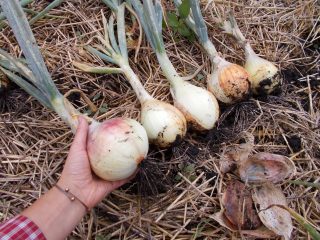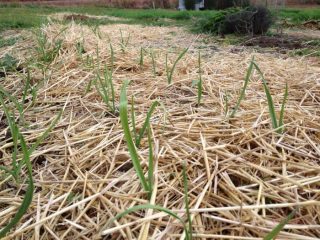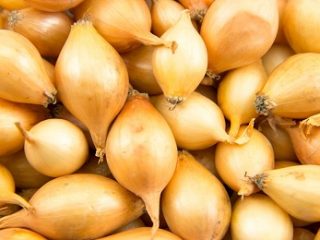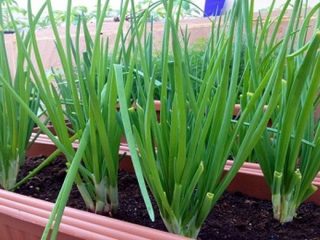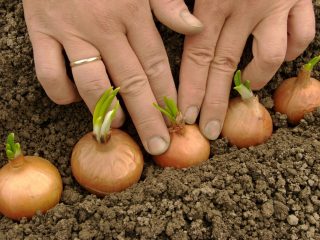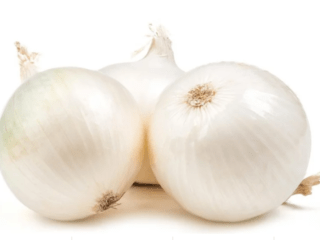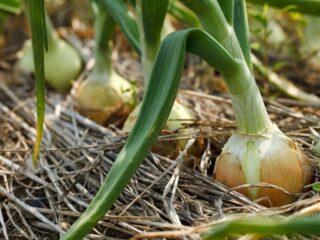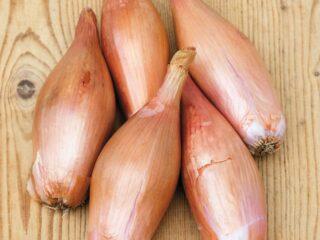Content
Bamberger onion is a medium-late variety popular in Europe. It attracts consumers with its unique shape, stable yield and other advantages. The variety is not included in the State Register of the Russian Federation, but it is successfully grown in many Russian regions. The crop can be planted in different ways; it is unpretentious in care.
Origin story
Bamberger onions were previously known under another name - Birnformige. The translation of the word means “pear-shaped.” The variety is of Dutch origin and was developed by Triumfus Onion Products. The company has been specializing in growing and processing onions for many years and exports its products to dozens of countries.
Description of the Bamberger onion variety
The Bamberger variety is distinguished by oval-elongated bulbs. The narrowing towards the bottom and neck is smooth. The bulbs do not exceed 10 cm in length and weigh on average 70-80 g.They have a tough light brown husk that is easy to peel.
The Bamberger variety has white and juicy pulp of moderate pungency. Its taste is slightly sweet.
Growing Bamberger provides not only onions, but also feathers. The greenery reaches a height of 40-50 cm.

Bamberger can be planted at the end of April or beginning of May; the variety is not afraid of the cold and loves soil saturated with moisture.
Characteristics of the variety
The neck of the Bamberger bulbs is of medium thickness. This property allows for long-term storage. The harvest can last until spring without much loss.
Ripening time and yield
Bamberger onion is a mid-late variety. Achieving technical ripeness takes 90-100 days. The duration of this period depends on the climatic characteristics of the region. In some areas it may take up to 130 days.
The Bamberger variety has high yields. On average, 7-8 kg of onions are harvested from 1 m².
Resistance to diseases and pests
Onion Bamberger has good immunity. The variety is resistant to the main diseases characteristic of the crop, but can suffer from onion fly larvae.
Composition and properties
The composition of Bamberger onions includes ascorbic acid and B vitamins. There are many other valuable elements in it:
- minerals – cobalt, silicon, copper, phosphorus, potassium, zinc, manganese, iron;
- Sahara;
- amino acids;
- Omega 3 and 6;
- phytoncides;
- flavonoids;
- saponins.
Bamberger onions are most useful in their raw form. The product has many useful properties:
- antibacterial effect;
- toning the body;
- increasing immunity;
- antiviral effect;
- prevention of oral diseases;
- acceleration of metabolism;
- anthelmintic property;
- stimulation of natural insulin production;
- decreased blood glucose levels;
- increase in potency.
Onions should be consumed in moderation - irritation of the gastric mucosa can lead to nausea and heartburn. For some gastrointestinal diseases, the product is prohibited completely or only in raw form.
Application
Bamberger is universal in use. Thanks to its sweetish taste and moderate pungency, onions of this variety are good fresh. Its elongated shape is ideal for cutting into rings, which is used in preparing salads and snacks.
Bamberger onions are recommended for canning and pickling. The variety is also suitable for heat treatment, especially frying.
Advantages and disadvantages
Gardeners appreciate the taste of Bamberger onions and their unique shape. The variety owes its popularity largely to its resistance to bolting.
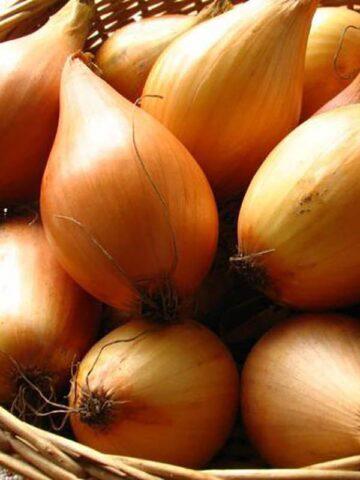
Bamberger onions are not prone to sprouting during long-term storage
Pros:
- elongated shape;
- good yield;
- adaptation to different weather conditions;
- juicy pulp;
- ease of peeling;
- long-term storage;
- immunity to most diseases;
- Possibility of landing in different ways.
Minuses:
- susceptibility to onion fly larvae;
- demands on soil fertility.
Bamberger onion planting methods
Bamberger onions can be planted with seeds or sets in open ground, or grown through seedlings. The culture feels good after legumes, cucumbers, tomatoes, cabbage. The variety prefers sandy loam or light loam and is demanding on soil fertility.
Growing seedlings from seeds
Growing Bamberger through seedlings allows you to get onions in one year. The process begins with preparing the seeds:
- Dip the nigella into the potassium permanganate solution for 40 minutes.
- Wash the seeds and dry them.
- Warm the nigella for 20 minutes in hot water (temperature up to 50 °C).
- Immerse the seed in cold water for a minute.
- Treat the seeds with Epin or another growth stimulant, following the instructions for the drug.
For sowing nigella, purchased soil or a mixture of equal parts of turf soil and humus is suitable. For better looseness, add vermiculite or coconut fiber.
You can grow Bamberger seeds in wooden boxes, pots or opaque containers. The sowing algorithm is simple:
- Fill the containers with soil with a layer of 8 cm.
- Moisten the soil one day before.
- Make holes or grooves 1 cm deep, leaving 3 cm between rows.
- Sow seeds at 2 cm intervals.
- Cover the plantings with soil.
- Lightly compact the soil.
- Moisten the soil with a spray bottle.
- Make a shelter out of glass or film.
Until seedlings emerge, keep the seedlings warm (optimally 25 °C). Then the shelter is removed and good lighting is provided. Seedlings can be kept on a windowsill or in a greenhouse. Caring for it consists of the following activities:
- regular watering - maintain moderate humidity, use warm water;
- thinning - leave 2 cm between adjacent sprouts;
- fertilizing seven days after sowing, then after two weeks;
- pruning when two leaves appear at 1-2 cm to stimulate the development of the root system.
You can feed Bamberger onion seedlings with a solution of chicken manure (1:10) or the following composition:
- a bucket of water;
- 5 g potassium chloride;
- 10 g urea;
- 20 g superphosphate.
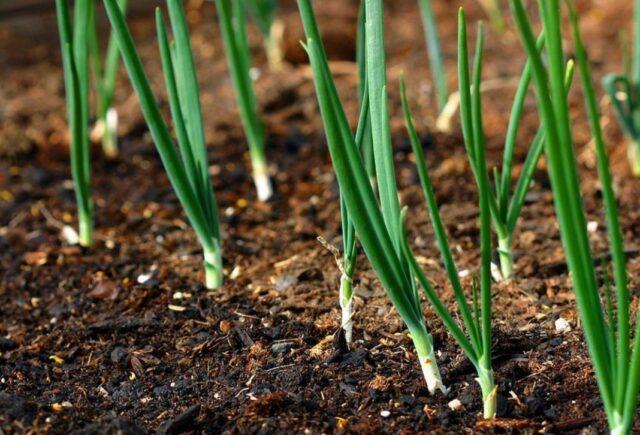
Bamberger seeds should be sown for seedlings approximately 50 days before moving to open ground
Seedlings are moved into open ground in the evening or on cloudy days after preliminary watering. The leaves are cut off by a third, the roots are shortened to 2.5 cm, treated with a mixture of clay and humus.
Planting seedlings in open ground in spring
For planting, you can use your own or purchased Bamberger sets. The raw materials must be dried to prevent spoilage. For 2-3 weeks before planting, it is kept in a warm place at 20 °C, then 24 hours at 35-40 °C. Another warming option is to immerse the bulbs in hot water for 20 minutes and treat them with a growth stimulator.
The Bamberger variety has good immunity, but it is better not to neglect prevention and treat the seedlings in a solution of potassium permanganate. Copper sulfate is also effective for disinfection.
The area for planting seedlings is prepared in the fall:
- digging;
- weed removal;
- burning of plant residues;
- adding organic matter, but not fresh manure.
For spring planting, take Bamberger seeds no smaller than 1 cm. Work procedure:
- Dig up the area and loosen it.
- Make holes, leaving 20-30 cm between rows.
- Plant the seedlings.
- Mulch the bed. You can use hay, straw, sawdust.
- If desired, lay covering material to speed up germination.
When planting sets, you can leave 10 cm between adjacent bulbs. This distance will increase due to the collection of greens.
Is it possible and how to plant Bamberger onions before winter?
Bamberger can be planted before winter. This should be done in late autumn, before persistent cold sets in.There must be at least two weeks before frost so that the crop has time to take root. Landing algorithm:
- Dig up the area in advance, add 5 kg of humus, 10 g of potassium sulfate, 20 g of superphosphate per 1 m².
- Before planting, add 10 g of wood ash per 1 m².
- Remove weeds, level the area, compact the surface.
- Make grooves at a distance of 20 cm.
- Distribute the dry seedlings into the recesses at intervals of 6 cm.
- Cover the planting with soil, do not moisten it.
- When frost occurs, mulch the bed. You can use dry leaves, spruce branches, and pine litter. Cover the mulch with branches.
It is optimal to deepen the seed by 5 cm. Before planting, it is sorted out. Bulbs from 3 cm in diameter are good for greens; smaller specimens are used for turnips.
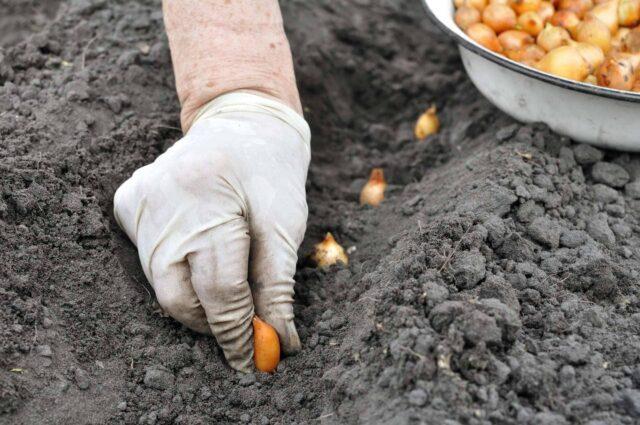
When planted in autumn, Bamberger will absorb moisture throughout the winter, becoming even juicier and tastier.
Caring for Bamberger onions
Bamberger onions are easy to care for. Culture needs standard events:
- watering - abundant during the first half of the growing season, then it is important to reduce it and stop a few weeks before harvesting;
- regular weeding;
- systematic loosening;
- application of fertilizers three times.
Feeding Bamberger varnish begins two weeks after planting, using a solution of chicken manure. After a month, nitrogen and minerals are added, and after another four weeks, potassium fertilizers are added.
With proper care and preparation for planting, growing Bamberger onions is trouble-free. The crop may be damaged by onion fly larvae.
There are several methods of struggle:
- insecticide preparations – Actellik, Aktara, Calypso, Enzhio;
- folk remedies - tobacco dust, decoction of pine needles, mint, valerian, ammonia solution, salt;
- repellent plants - carrots, tomatoes, mint.
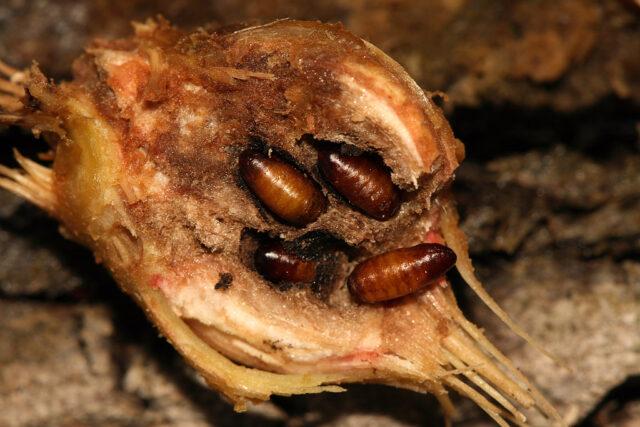
Infection with onion fly leads to the death of plants, rotting of the bulbs, and the appearance of fungus
Conclusion
Bamberger onions have a sweetish, moderately pungent taste, are versatile in use, and suitable for long-term storage. The variety can be planted with seeds or sets, in spring and before winter. Bamberger is unpretentious in care and is resistant to diseases and most pests.
Reviews from gardeners about Bamberger onions
